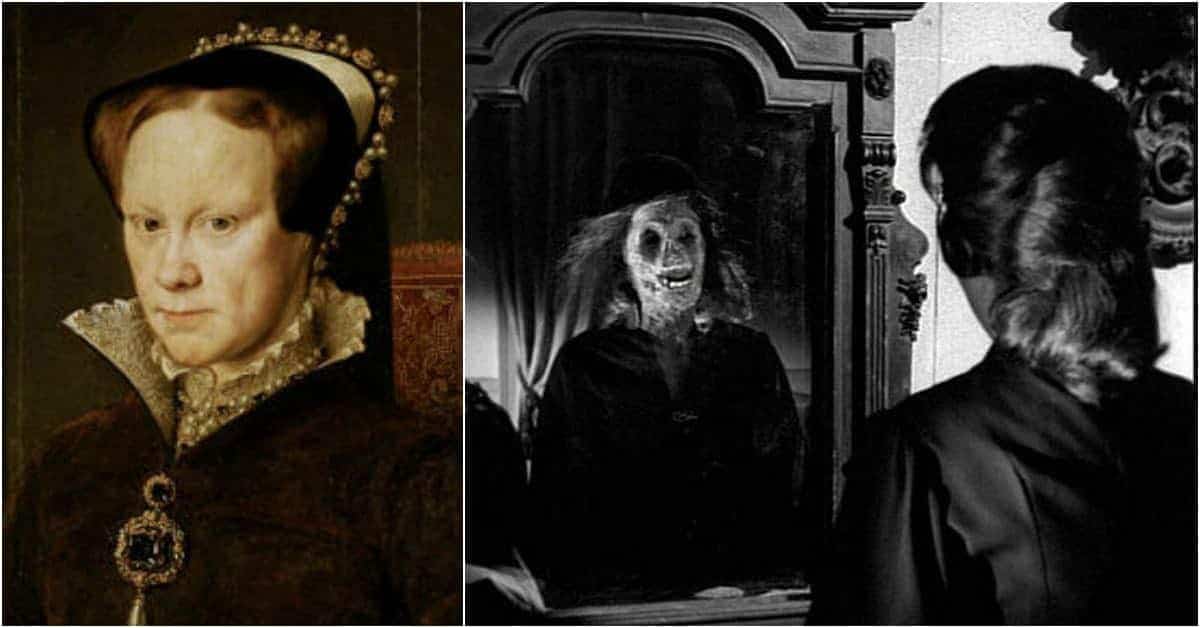As most of us know, standing alone in a darkened room, quietly muttering Bloody Mary into a mirror isn’t just something adults do when they’ve had one too many vodka tomato juices the night before. Since at least the second century AD, scare-seekers and the superstitious have been dabbling in catoptromancy (the act of divination using a mirror) for any number of divinatory reasons.
In Ancient Greece, sick people would visit temples where they would look into a mirror. If a healthy-looking apparition stared back at them, they were expected to recover; if the apparition was terrifying, their days were numbered. In Edwardian Britain, young women would look for visions of their future husbands in candlelit mirrors. If he appeared, all was well and good. If a grim spectre appeared, it was divined she would die before she married.
Mirroring “Bloody Mary” is the Japanese legend of Hanako-san (or “Hanako of the Toilet). It involves a young girl, killed either during WWII air raids or by a parent or stranger, who appears in the mirrors of school bathrooms when you shout her name. But the invocation of Bloody Mary—a blood-soaked spectre just as likely to be benign and scare you as to end up strangling you—is relatively recent. Who exactly do scare-seekers in the West expect to come face-to-face with when they summon Bloody Mary? Here are three historical contenders.

Bloody Mary 1) Queen Mary I (1516 – 1558)
Mary I of England could have had historical laurels to her name. She was the only offspring of Henry VIII and his first wife, the Spanish queen Catherine of Aragon, to survive childhood. She was also England’s first queen regnant—that is the first queen to rule in her own right rather than as the wife of a king. But what Mary I is instead most (in)famous is for being ardent Catholic, whose burning devotion to her faith earned her the nickname “Bloody Mary”.
As the blood queen of the English Reformation, Mary had at least 280 people burned at the stake for resisting her re-Catholicisation of England. These purges, known to history as the “Marian Persecutions”, were aimed at those who remained loyal to Protestantism—a religious sect embraced by Mary’s father, Henry VIII, and his son and brief successor, Edward VI, but rejected by the Catholically-raised Mary. And not only did Mary execute those who refused to renounce their Protestantism, she also burned people who did.
Her most famous victim was Thomas Cramner, the Archbishop of Canterbury. After his trial, Cramner renounced his faith and re-embraced Catholicism. However, Mary had a score to settle. As an advisor to her father, Cramner had been responsible for annulling Henry’s marriage to Mary’s mother, Catherine, so Henry could marry Anne Boleyn. He’d also been a passionate promoter of Protestantism under Mary’s predecessor, Edward VI. So Mary ignored the law of repentance—which should have absolved him—and condemned Cramner to the flames anyway in 1556.

Even for the standards of the time, the burnings were seen as being gratuitously nasty. They were met with hostility among the English population, serving only to fan the flames of anti-Spanish sentiment. Worse still for Mary and her Catholic supporters, it was all in vain. For upon Mary’s death, and the accession of her successor, Elizabeth I, England was steered back towards Protestantism. Rather than a turning point in England’s sectarian history, Mary’s persecutions were a minor—though no less bloody—blip.
Mary was betrothed at the age of just two and married a series of powerful royals across Europe. But she was never able to produce an heir. Aged 37 she seemingly became pregnant, displaying all of the symptoms, but never gave birth. Medical experts now suggest she may have suffered from pseudocyesis: a condition that essentially ghosts a pregnancy by producing all the symptoms. She fell pregnant again but died, aged 42, during an influenza epidemic in 1558. It wasn’t influenza that got “Bloody” Mary I, though, but ovarian cysts or uterine cancer.

